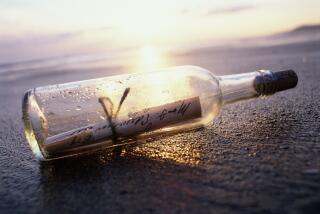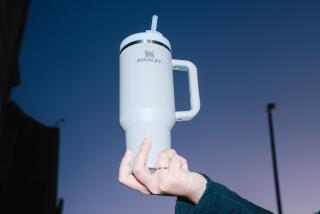Return to SenderReturn to Sender
- Share via
It sometimes takes years for Earl Seagars’ messages to be returned. But people do return them, and that’s more than certain power-breakfasting Angelenos can say. In fact, Seagars considers his 30% to 40% return rate exceptional. Why? Because “Uncle” Earl, as he is known in the sailing world, communicates the really old-fashioned way: by bottle.
For the past 20 years, the Orange Coast College meteorology instructor has sent hundreds of bottled messages over the shifting rails of sailboats to learn more about ocean currents. Whether competing in the annual Transpac or cruising through French Polynesia, every day at noon Seagars consigns a numbered wine bottle to the sea, noting its exact position. Stuffed inside is a request for the date and location where it is found.
Seagars’ bottles bob along at the mercy of wind and current. Some make it only a few miles before washing ashore; others become trapped in an infinite loop of mainstream currents or snarled in the thick weeds of the Sargasso Sea. But for every two bottles lost, one completes an ocean crossing.
Although scientists now use transponder-equipped buoys to study ocean currents, bottle-tossing has a long tradition. Benjamin Franklin used them to study the Gulf Stream, and sailors still rely on pilot charts that 19th century naval officer Matthew Fontaine Maury created from bottles set adrift. Seagars’ twist: a reward for a completed and returned form. “Of course, I don’t include the fact that it’s only $5 or $10,” he says. “I’d probably get a lot fewer responses.”
As it is, he gets a reply about once a month, from China, Casablanca, Tokyo, Papua New Guinea, the Azores, the Marquesas--just about anywhere with a stretch of sand. Many times, says Seagars, the people who find the bottles prove more interesting than the meteorological information gained.
Take bottle number 13 of 1984 (a very good year, with 11 of 25 messages returned). Dropped five miles west of Coos Bay, Ore., it traveled 21 months and more than 7,000 miles with the California and north equatorial currents to the Philippines. The finder began his reply: “I am a poor fisherman living in a napa hut, married with six children . . . .” A month after Seagars sent the $5 reward, he received another letter, from one of the fisherman’s lady friends. This one included a detailed description of her figure along with a photograph. Seagars sent a nice, moneyless answer.
Seagars’ greatest vicarious voyage so far came in January. While vacationing in the Bahamas, a Massachusetts family counselor stumbled across one of his bottles during a moonlit walk. “I released that bottle in 1982,” Seagars says. “It must have made three or four circuits of the Atlantic before it landed. If that bottle could only talk . . . . “
More to Read
Sign up for The Wild
We’ll help you find the best places to hike, bike and run, as well as the perfect silent spots for meditation and yoga.
You may occasionally receive promotional content from the Los Angeles Times.






